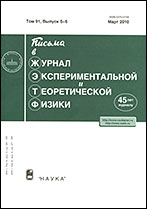|
|
Pis'ma v Zhurnal Èksperimental'noi i Teoreticheskoi Fiziki, 2005, Volume 82, Issue 4, Pages 217–222
(Mi jetpl1537)
|
 |
|
 |
This article is cited in 62 scientific papers (total in 62 papers)
CONDENSED MATTER
“Destruction” of the Fermi surface due to pseudogap fluctuations in strongly correlated systems
È. Z. Kuchinskii, I. A. Nekrasov, M. V. Sadovskii
Institute of Electrophysics, RAS Urals Branch
Abstract:
We generalize the dynamical-mean field theory (DMFT) by including into the DMFT equations dependence on correlation length of pseudogap fluctuations via additional (momentum dependent) self–energy $\Sigma_\mathbf k$. This self – energy describes non-local dynamical correlations induced by short-ranged collective SDW-like antiferromagnetic spin (or CDW-like charge) fluctuations. At high enough temperatures these fluctuations can be viewed as a quenched Gaussian random field with finite correlation length. This generalized DMFT+$\Sigma_\mathbf k$ approach is used for the numerical solution of the weakly doped one-band Hubbard model with repulsive Coulomb interaction on a square lattice with nearest and next nearest neighbour hopping. The effective single impurity problem is solved by numerical renormalization group (NRG). Both types of strongly correlated metals, namely (i) doped Mott insulator and (ii) the case of bandwidth $W\lesssim U$ ($U$ – value of local Coulomb interaction) are considered. Calculating profiles of spectral densities for different parameters of the model we demonstrate the qualitative picture of Fermi surface “destruction” and formation of “Fermi arcs” due to pseudogap fluctuations in qualitative agreement with ARPES experiments. “Blurring” of the Fermi surface is enhanced with the growth of the Coulomb interaction.
Received: 09.06.2005
Citation:
È. Z. Kuchinskii, I. A. Nekrasov, M. V. Sadovskii, ““Destruction” of the Fermi surface due to pseudogap fluctuations in strongly correlated systems”, Pis'ma v Zh. Èksper. Teoret. Fiz., 82:4 (2005), 217–222; JETP Letters, 82:4 (2005), 198–203
Linking options:
https://www.mathnet.ru/eng/jetpl1537 https://www.mathnet.ru/eng/jetpl/v82/i4/p217
|


| Statistics & downloads: |
| Abstract page: | 333 | | Full-text PDF : | 88 | | References: | 77 |
|





 Contact us:
Contact us: Terms of Use
Terms of Use
 Registration to the website
Registration to the website Logotypes
Logotypes








 Citation in format
Citation in format 
